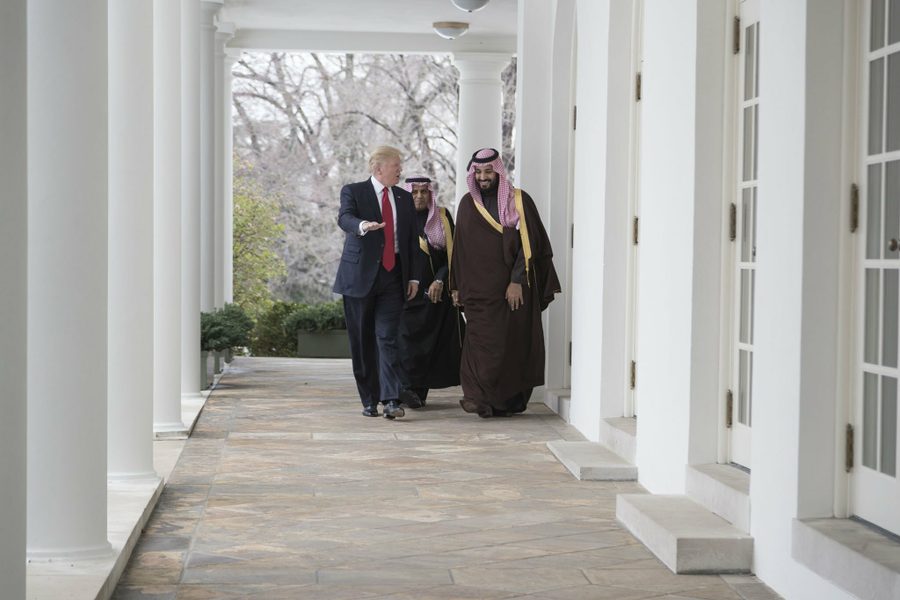Trump’s Quiet Meeting with Saudi Arabia and Israel Portends a Dangerous Collision Course with Iran
An under-the radar gathering at the White House exposes troubling new drifts in U.S. foreign policy.
Phyllis Bennis

This article was produced in partnership with Foreign Policy In Focus.
It was a lot to take in, even in these whipsawed media moments.
In one 24-hour news cycle, President Donald Trump fired Secretary of State Rex Tillerson, appointed the war and torture-backing CIA chief Mike Pompeo to replace him, and then tapped Gina Haspel — who covered up CIA torture in Thailand — to replace Pompeo.
While the media descended on that circus, many missed that the White House quietly convened high-level representatives of 20 countries ostensibly to “brainstorm” about the crisis in Gaza, where Israel’s repeated military incursions and blockade have devastated the territory’s infrastructure, health and water systems.
The gathering, which took place on March 13, was less splashy than the Tillerson-Pompeo-Haspel saga. But it spoke volumes about dangerous new drifts in U.S. foreign policy.
Look who’s in the room together
The United States has long backed Israel’s siege of Gaza and defended Tel Aviv’s succession of military assaults on the impoverished, densely populated territory of 2 million.
So the notion that Trump, whose uncritical support for the Israeli government surpasses that of any of his predecessors, is suddenly concerned about mitigating the humanitarian catastrophe in Gaza seems pretty far-fetched. Especially when Israel, the country most immediately responsible for the destruction of Gaza, was one of the nations playing a starring role in the White House gathering.
On the humanitarian front, little came of the meeting. Officially, Reuters reports, “the multi-nation humanitarian and reconstruction effort remains in beginning stages.”
More significant than the outcome, however, is the grouping the meeting brought together.
The gathering featured Europeans, Israelis, Egyptians and representatives of most of the Gulf Arab monarchies — Saudi Arabia, the UAE, Jordan, Qatar, Oman, and Bahrain — all sitting in the room together. Not included were Palestinians, who have been clear they won’t follow U.S. diplomatic leadership since Trump’s provocative decision to move the U.S. embassy to Jerusalem.
According to Reuters, unnamed officials insisted that “the format did not allow for direct discussions between Israel and the Arab states.” But that is likely not the end of the story.
It’s been clear for a long time that Israel and the Gulf monarchies, led by Saudi Arabia, are desperate to cozy up to each other. Both are U.S. allies and huge purchasers of U.S. arms. And both rely on U.S. diplomatic protection at the United Nations to avoid accountability for their human rights violations.
And most importantly, at this moment, both sides are eager to join forces against Iran.
Saudi Arabia and Iran have been battling for regional dominance for a long time. Their competition has stoked a brutal proxy conflict in Syria, and Saudi Crown Prince Mohammed bin Salman has orchestrated a devastating attack on Yemen as a challenge to Iran’s influence there.
Meanwhile, Israeli Prime Minister Benjamin Netanyahu’s efforts to persuade the United States to abandon the nuclear deal and attack Iran have served as a backdrop to Israel’s regional policy for years.
At a quiet Washington meeting supposedly discussing something quite unrelated, they were all sitting down together — ahead of Saudi Crown Prince Mohammed bin Salman’s own visit to Washington.
A dangerous regional agenda
Despite years of Israeli and Saudi propaganda, Iran isn’t actually an existential threat to either Israel or to Saudi Arabia. But Iran’s rise is definitely a challenge to long-standing Israeli and Saudi efforts at regional dominance.
The more dire regional threat, however, is that the Trump administration is showing every indication of wanting to escalate tensions with Iran. That’s exactly what will happen if the Trump administration pulls out of the Iran nuclear deal, as Netanyahu continues to urge, and as Senate Foreign Relations chairman Bob Corker (R-TN) recently predicted.
Trump’s appointment of Mike Pompeo, a leading Iran hawk, to the post of Secretary of State increases this risk. Pompeo has gone even beyond Trump himself in criticizing the Iran nuclear deal, a position that bodes very badly for diplomacy under this potential new diplomat-in-chief. So does the fact, as Peter Beinart wrote in The Atlantic that “Pompeo embraces anti-Muslim bigots, and defames Muslims, with almost as much gusto as Trump himself.”
As Secretary of State, it will be up to Pompeo to inform the president whether or not Iran is complying with its obligations under the nuclear deal. The international agency charged with monitoring Iran says it is complying. But Pompeo, even before he became CIA director, was already tweeting that he was looking forward to “rolling back” the “disastrous” nuclear deal.
Palestinians left out
With these people running U.S. foreign policy, any moves by Washington to encourage the Israeli and Gulf Arab governments to join forces against Iran becomes even more dangerous.
Tel Aviv and Riyadh are both eager for this front. What stands in their way is popular outrage at home.
In places like Saudi Arabia, absolute monarchs shed crocodile tears about the plight of Palestinians while doing nothing to actually end Israel’s oppression of Palestinians. But thanks to widespread popular support for the Palestinian cause in the Arab world, Arab officials are pretty much forbidden to publicly meet with Israelis.
Trump son-in-law Jared Kushner and his BFF Prince Mohammed bin Salman are working to change that. Getting Saudis and others in the region accustomed to the idea of Israelis and Arab leaders sitting in a room together is a key component of this strategy. That not-so-public meeting in the White House may have been just the beginning.
Once again, the Palestinians — and especially the people of Gaza — are being held hostage to the regional and global aspirations of more powerful countries. Instead of actually addressing the suffering in Gaza, the United States and its allies may have turned a conference on humanitarian assistance into a war room aimed at Iran,
Phyllis Bennis is a fellow of the Institute for Policy Studies and serves as international adviser for Jewish Voice for Peace. She is the author of the new book Understanding Palestine & Israel, from Interlink.








